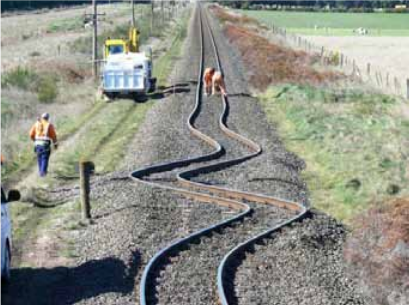

IS THE TECHNOLOGY BEING USED FOR THE INLAND RAIL, NAMELY LOCOMOTIVE-RAIL, PAST ITS “USE-BY DATE”?
By: Kevin Loughrey BE Mech (hons) Date: 16 July 2018 (first commenced)
At a National Party Annual General Meeting at Hastings Point, on 11 July 2018, I voiced my misgivings about the Inland Rail Project that was, at that time, being enthusiastically promoted by the leadership of the National Party.
To avoid any misunderstanding regarding my position on this project, I strongly support the idea of a mass transportation corridor through inland Eastern Australia as well as exciting ideas like "The Iron Boomerang"; presently conceived as a coast-to-coast railway line across the top half of Australia. It fits with a broad sentiment, held by many thought-leaders in Australia, that, for many reasons, these being in part;
My concern with this project relates to the technology being used.
To refresh readers, the intention of the inland rail project is to build a single, dual gauge railway from Melbourne to Brisbane. The rail will be laid on crushed rock, referred to as "ballast". Ballast requires frequent maintenance. Having only a single railway track,over a thousand kilometres long, means that some part of it will always be out of commission, undergoing maintenance.

Fig 1. Railway Maintenance - What can happen!
Time-saving, Cost and Flexibility. Using autonomous-capable vehicles, it is possible to load them with goods at the factory, transport the goods long distances using the dedicated pavement and then deliver these goods directly to the warehouse or point of consumption at the end of their journey. With a rail system there will be at least two loading and unloading operations. The ability to move goods directly from source to destination without cross-loading significantly:
improves the speed of goods transit,
reduces the chances of loss and damage,
reduces the cost of the overall operation, and
allows greater flexibility with respect to the location of factories and warehouses.
Speed of Transportation. I have, in 1. above, indicated how, with autonomous vehicles, significant time and effort is saved by not having to cross load cargo. Autonomous vehicles also do not take existing technology to its limits as is the case with high speed trains; especially the Mag-Lev. Autonomous vehicles can easily travel with excellent safety at 120kph without any exceptional technology being employed. If the distance from Melbourne to Brisbane, for example, is approximately 1,200km, this distance could be covered in around 10 hours of non-stop driving. This would be a significant improvement on present transportation times by either existing road or rail.
Energy Efficiency. When vehicles travel at 120kph their rubber tyres become “solid” and rolling resistance reduces dramatically, being close to that of steel wheels on steel rails. The difference, however is that rubber tyres grip the pavement far better and therefore can brake far more effectively than is the case with steel wheels on steel rails.
Unions. The use of autonomous vehicles greatly reduces the size of the workforce that would be employed in this enterprise and allows the engagement of contractors; both as owner-operators of vehicles and maintainers of the pavement. A dedicated railway line will become, over time, heavily unionised, resulting in inefficient working practices, unnecessary management and administrative overheads, all resulting in higher costs. Every consumer in Australia will pay for this as is presently the case with Australia's heavily unionised maritime ports. Given the size of investment in a heavy transport vehicle, making it capable of autonomous operation on a pavement, designed and dedicated for this purpose, would not be seen by many independent operators to be unaffordable. Having multiple commercial participants in this enterprise will help introduce the essential element of competition and diversity which in turn brings efficiency and new ideas.
Construction. Using the techniques and machinery I studied in Germany, it would be possible to construct this pavement very quickly. Certainly at a rate, and at a cost that would be comparable to that of constructing a railway line. Construction is simplified because these vehicles, travelling on rubber tyres, can negotiate far steeper gradients and operate in more adverse weather conditions than can trains with steel wheels running on steel rails. These vehicles are also less sensitive to road camber on corners whereas rails have to be tilted at a precise angle to match the planned speed of the train. Failure to do this, or if the train does not travel at the planned speed, results in excessive wear on the rails and the flanges of the wheels of the train; leading to higher maintenance costs and downtime.
Elimination of Switching Systems. Autonomous vehicles, operating on a dedicated pavement, do not require complex electro-mechanical switching systems as do trains. These systems are expensive to install, operate and maintain and they have significant reliability issues.
I am concerned this project is being driven by well-intentioned people lacking in professional engineering qualifications and experience. It is then being carried forward by those who have a self-interest in the income to be derived from this project but with little concern about the effectiveness and commercial viability of the end result.
Lastly, I believe now is the time we should change the direction of this and similar projects such as the "Iron Boomerang". Much of the work that has been done, such as plotting a suitable corridor and funding this project is still relevant if we were to transition to the idea of a pavement dedicated to autonomous vehicles. Orders for steel and concrete are still relevant except that the steel shall be used for reinforcing concrete rather than the construction of steel railway lines and the concrete shall be used for pavement instead of rail sleepers.